Amish Women’s Clothing – What Differences Do You Notice? (16 Photos)
Reader Jim Halverson, who gave us a look at the Amish of Lagrange County, Indiana last summer, recently attended Yoder’s Consignment Auction in the same community.
Jim spotted differences in the styles of clothing of those in attendance – particularly noticeable in the women’s dress.

Clearly the Amish at the event were not all from the same community (not a surprise for a large auction). What do you notice as far as differences in these photos?
First, here are some photos of Amish women and girls with similar dress and kapp styles:
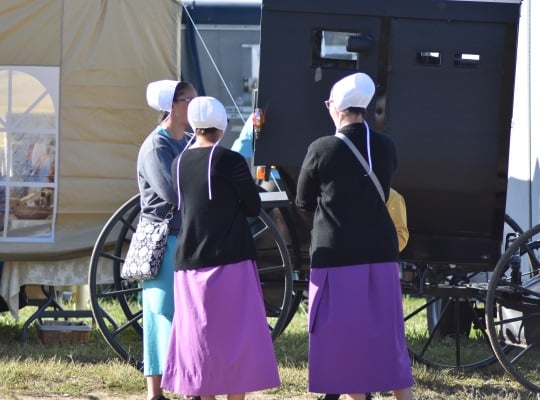


Jim found this next group of photos to show distinctly different dresses. What do you notice? What community or communities might these dress styles be from?




There was also someone wearing a black dress. Amish women wear black dresses to signify a period of mourning after losing a loved one.
The dress communicates something to those in her community. It’s a reminder that she has lost someone close to her (for more, see The Amish pp. 246-7).

The amount of time a woman will wear the black dress can vary by local custom, or based upon how close the relationship was – e.g., a closer relation like a spouse or parent, vs. a more distant relation like an aunt or first cousin.
Here is something different. Are these women Amish?

Note the covering style, how it sits on the head, and also the hairstyle.

Two women in this next photo stand out.

Zooming in closer:

There is a small Old Order Mennonite settlement not far from this Amish community.
Finally, in this photo, Jim notices three different styles of kapp on the women on the right:
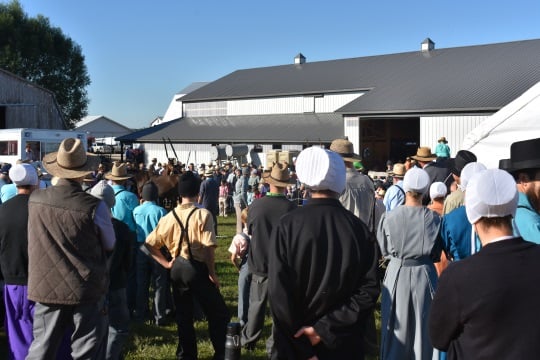
Zooming in a bit:

And even closer. Looking carefully you can notice the style of each of these three kapps is distinct:
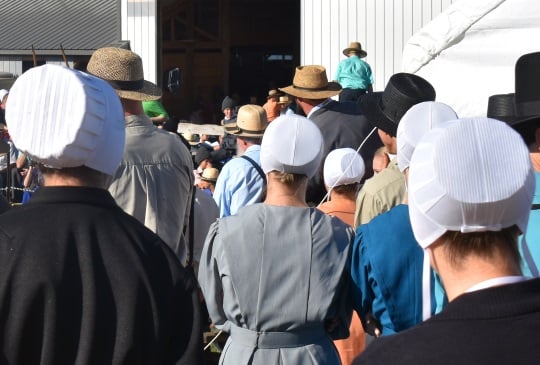
For comparison, we had a look at different Amish women’s kapp styles earlier this year (see this post for more examples).
Here you can see subtle but clear differences in the styles, captured in this single shot.
Plain clothing: different styles, worn for similar reasons
The above examples of women’s clothing (excluding the Mennonite photos) can all be considered both “Plain” and “Amish”.
Yet the styles are clearly different. These differences are immediately noticeable to Amish people, who grow up and live everyday immersed in their local styles.
And as we see in several of the above photos, Mennonites and other plain Anabaptists also wear their own distinct styles of clothing.
Some Amish have more conservative – “plainer” – styles of dress than others. You can notice this in things like the color of the material, the amount of material, the cut and so forth.
In some communities you will see brighter colors in women’s or girls’ dresses – yellows, pinks and even shades of red.
In others, dark browns, purples, and blues are the firm standard.
An auction, or other gathering that brings in people from other communities (a wedding or a funeral for example), are prime opportunities to notice these differences in one place.
No matter the exact style, Amish and related groups choose to wear Plain clothing for a number of important reasons, including modesty, practicality, and identity.
If you’d like to know more about Plain clothing, and on the differences across the many Amish and other Plain groups, Why Do They Dress That Way? by Stephen Scott is a great resource.
And a special thanks to Jim for sharing the photos.



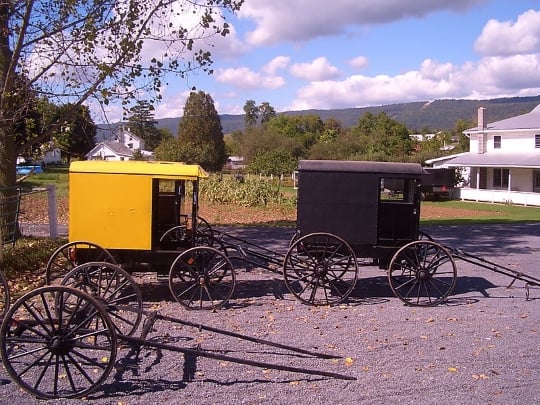


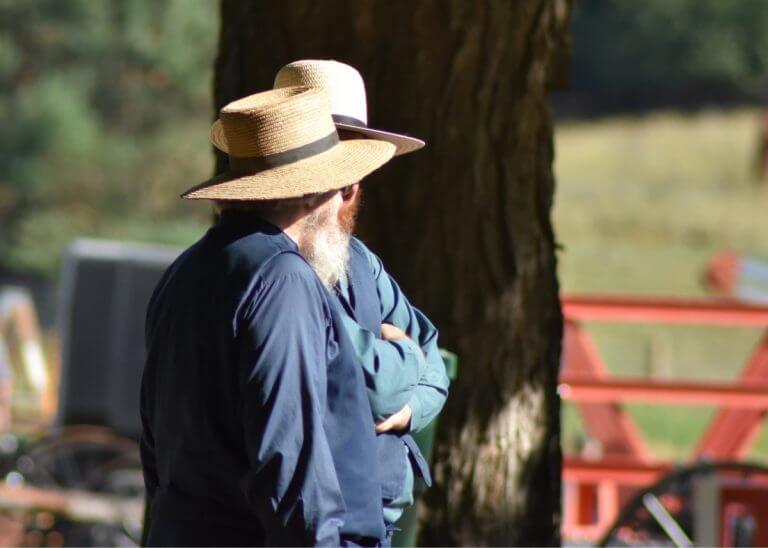
Amish in the past
There are no Amish in the state I live in now, but in the early 60’s I used to see Amish in SE Penn that I thought only dressed in black. That’s what I remember anyway. Am I wrong? Then in the early 80s I lived in NW Penn and I remember the Amish women only wore black ankle boots. That seems to have passed also. I loved that old formal look!
Neat memories Debbie, I wonder if clothing at that time in SE Pennsylvania (would you mean Lancaster County) wasn’t simply more conservative in general, which would traditionally mean darker colors. We’ve actually got a couple posts with photos from around that era from Lancaster County, so you can see if anything here looks familiar. In the second of these, you can see one photo of Amish women wearing what appears to be particularly dark and heavy dress:
https://amishamerica.com/lancaster-county-50-years-ago/
https://amishamerica.com/lancaster-county-50-years-ago-part-2/
I’m not sure about the NW PA community – do you remember the name of the location?
Amish in the past
Thank you for your reply, Erik. Those photos are not in color, so I can’t tell if they are all in black or not, but the heavier clothing looks more familiar to me. My family would cross the PA border from Md, I was a young child, so not sure exactly where. Unfortunately, I have to confess that I was terrified of the Amish & was told to stay away! The beards scared me most of all, American men did not wear facial hair in the early 60’s. The Amish were much more segregated in those times. Around 1982 I lived in Clarion, PA north of Pittsburgh. The Amish flowed through the community much more easily, not sure where they lived, but I do remember all the women & girls wore black ankle boots.
Ha Debbie that’s funny to think, but I can see how that might scare a young child – beards, unusual dark clothing, etc. And I would guess that there was less contact between the English and the Amish who were much more often farmers at that time (not businesspeople having daily contact with English customers) so it makes sense.
SE PA Amish
I have never been there myself, but I know there is old order Amish in Springs PA. Just over the MD/PA border.
Types of dress
I didn’t see any heart shaped kapps in these pictures. Which community wears heart shaped kapps? I have always wondered about that. Thanks!
Heart-shaped Amish kapp
Sure thing Valerie, those would be worn by Amish from the Lancaster County settlement, and the spin-off settlements that have come from that community. There are actually at least two such Lancaster-heritage settlements in Indiana, both of pretty decent size, but I didn’t notice any of the heart-shaped kapps in the photos either, so I’d assume not many from those communities came to this sale.
Types of dress
Thank you for the reply about heart shaped kapps. In the Amish fiction books I read, the characters wear heart shaped kapps, and now that I think about it, most of these books take place in Lancaster county. Thanks for clearing this up for me!
Sure thing Valerie!
Here in Upstate NY...
Here in Upstate NY – west of Albany – the Amish are everywhere. I in fact, have a family that lives behind me and owns the property adjacent to me. They also have the heart shaped kapps and wear a traditional medium blue or dark blue garb for the women and a combination of the 2 for the fellas.
Nice, sounds like those are Lancaster County-origin Amish (or possibly from a Lancaster sister settlement). Lot of Amish have found New York an attractive place recently to start new communities.
The women wearing black kapps and capes (and the women in a black dress & bonnet with no cape) are from Berne, IN, or a similar settlement. The colored bonnets & women with slightly thinner, looser kapps are Old Order Mennonites.
Thanks Yoder, I figured they were from Berne area or related. On that note, how would you describe the Allen County clothing compared to Adams County (if you know offhand)? I have spent a good bit of time in Allen Co. but I’m not really remembering how the dress would compare. Since they’re related groups I guess it’s similar, but the only thing that comes to mind is maybe it’s a “lighter” style compared to this heavier Adams County look.
Allen County clothing
Erik, I was in Allen County a few months ago and noticed lighter colors than seen in Berne, and lighter than my last visit a few years ago. Allen County folks seem to favor black trousers rather than the very dark triblend denim common in Berne. The straw hats are often the twisted seagrass type (my favorite to wear, actually) in Allen Co., while Berne seems to favor a plainer, more traditional make. I’ve also noticed the men’s suspenders are often the ones with the diamond pattern here, but U think Berne folk favor plain black. Women’s bonnets over the kapp aren’t as common, either. Sock caps are more common in the winter in Allen Co., I think, and I saw one young man with one this summer-something I had only seen in Elkhart/Lagrange before now. Another innovation in Allen Co. was bicycles. Bicycles were everywhere. A friend confirmed that up until a year or year and a half ago, bicycles were forbidden here. When her son had one way back (he might not have even been a member yet, she didn’t say), they heard about how horrible bikes were in church every time they met. Allen County appears to be getting more materially progressive, looking more like Elkhart/Lagrange than it used to. I suspect the prosperity of the building trades here has had a lot to do with it. The friend of the grandson of the friend mentioned earlier informed me that in the Ft. Wayne area, the Amish here are now the dominant framing crews and around 300 Amish construction crews are working every day.
Thank you Nicholas, great info. When I first went to Allen County in 2006, I remember seeing the Lancaster-style scooters everywhere. I did not know that bicycles were becoming accepted in the community now, interesting. I also remember the dominance of the building trade back then. It was difficult to catch any of the men of the house at home during the day (I was selling books at the time) as most were off on construction jobs, and there were almost no farmers and very few home businesses compared to other sizable communities.
I love “Why Do They Dress That Way?”, and I hope that an updated edition is published one day, though it is a shame Mr. Scott is not alive to update it himself.
I agree on both counts. I’d actually like to see one that focuses strictly on Amish clothing. Steve did go quite in-depth on Amish dress, though a good portion of the book was on other groups (Mennonite, Orthodox Jews, other Plain Anabaptist). That is an interesting aspect of his book though, and to be able to compare across even non-Amish groups.
Hey Erik, Do you have any articles or information on where I could find a list of Amish Health and Wellness Expos throughout the US?
I’m not exactly sure what an Amish Health and Wellness Expo is!:) There was just a conference on the topic in June at Elizabethtown College. Do you mean something where health products are sold or something like that?
At the Amish & Mennonite Heritage Center in Berlin, Ohio, there is a very interesting display of many different Amish and Mennonite women’s head coverings from various affiliations. I would be interested in seeing a display of Amish and Mennonite men’s hats — straw hats, felt hats, etc.
I have learned that men from different affiliations wear different styles of hats. Some of the differences in style might only be in the width of the brim of the hat.
A couple of times I have been with friends who were formerly Amish at large gatherings such as Horse Progress Days where there are Amish and plain Mennonites from many different settlements and affiliations in different states. It has been interesting to see how quickly my friends can identify which affiliation a person or couple is from just by looking at the woman’s head covering or the man’s hat. Horse Progress Days, with an attendance of several thousand, is the place where I have seen the largest variaton of Amish and plain Mennonite attire.
Al something that goes in detail on that would be interesting. I’m not sure if you caught it, but I was able to make some photos at the Center and do a post on those women’s head coverings earlier this year: https://amishamerica.com/amish-womens-head-coverings/
There actually were a number of Amish hats on the wall, but for some reason I didn’t make many photos of those. I can’t remember if they were labelled or not like the women’s coverings were; if not, that might have been why.
Thanks for mentioning the previous post about the display of women’s head coverings at the Amish & Mennonite Heritage Center in Berlin. I think I missed it the first time, so went back and read it. It’s a very good, informative post, especially for persons who will never have the opportunity to see the display at the Center.
Amish Pen Pals
Can you tell me how I would go about getting a couple of Amish pen pals?
Amish Pen Pals
I too would like to know about Amish Pen Pals.
Community differences in clothing
My observations from these photos are: (photo numbering starting at the first picture including people)
Photo #2-Holmes county based on the young man’s light denim broadfalls and what might be a red polo shirt. Polo shirts are not too uncommon in parts of Amish Ohio and Lancaster County, in my understanding. It’s because the older preferred style of shirt from the 1800’s had 3 buttons and polos seem to be an accepted alternative to making the 3-button shirts.
Photo #3-girl on the far right with a black kapp and blue dress might be Swiss Amish
Photos #4, 5, 6, 7, & 8-all the women with the different dresses with black bonnets over their kapps are probably from Adams County, Indiana as the styles seen here are common in that community. The man in #8 to the right of the woman in mourning is also dressed in a style common to Adams County.
Photos #9 & 10-the women in the rather different kapp styles are probably Amish Mennonite (such as the Beachys) or a church in the Conservative Mennonite movement. The woman on the right is definitely Mennonite as what little of her dress is visible above the sweatshirt is patterned.
Photo #11-as noted, Old Order Mennonite bonnet styles over the kapp. There are a couple Swiss-style black kapps also visible.
Photo #15 (final photo)-the kapp in the middle might be the local Elkhart/Lagrange style, but I’m not positive.
Thanks for the photos! It was neat to see the variations!
PS-back before the 2009 split in the Old German Baptist Brethren, one of my friends use to play a game he called “Spot the Pennsylvanians” which worked by looking for the most conservatively/traditionally dressed people and trying to determine if they actually were from PA, which is stereotyped as the most conservative of all German Baptist areas. The level of conservative dress in other communities since the split has made it more difficult to play this “Where’s Waldo” type game. In the German Baptist New Conference, we just look to see who’s still wearing a hat to find the more traditional folks. I personally confuse everybody by wearing my hat with colored dress shirts instead of the traditional white.
Covering Material(s)
The variety and subtleties of the differences of women’s various covering styles, even among related & nearby “branches” of the same or similar Amish denominations are fascinating to me, yet I can also think of them as little different from the styles of non-Amish women from neighboring locales and even churches. It’s fairly easy, I think, to tell whether a women is from the “town” or “county”, for example, based upon clothing style whether they’re Amish or English! I do not envy those whose coverings have so many pleats, I must admit!
Footwear
What strikes me is how different the shoes are: black leather shoes, tennis shoes, sandals… there seems to be little constraint on that!
Interesting.
This is unique information. Thanks for share
Noticed
I notice that you wrote very preciously. Easy to read and understand. Thanks
https://www.topsandbottomsusa.com/collections/iceberg
Lovely lovely
Oh my god, what close are Amish to Muslim people, exclusively Iranians!
So lovely they are.
Specially their lifestyle and habits.
I am enjoying every things I read about them. I feel so close with them.
We are not alone on globe any more .